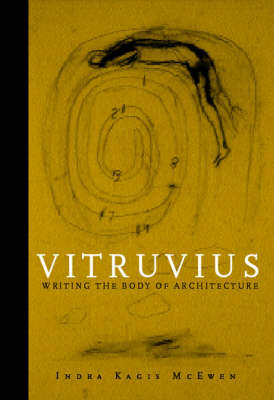MIT Press
2 total works
Vitruvius's De architectura is the only major work on architecture to survive from classical antiquity, and until the eighteenth century it was the text to which all other architectural treatises referred. While European classicists have focused on the factual truth of the text itself, English-speaking architects and architectural theorists have viewed it as a timeless source of valuable metaphors. Departing from both perspectives, Indra Kagis McEwen examines the work's meaning and significance in its own time.Vitruvius dedicated De architectura to his patron Augustus Caesar, the first Roman emperor, whose rise to power inspired its composition near the end of the first century B.C. McEwen argues that the imperial project of world dominion shaped Vitruvius's purpose in writing what he calls "the whole body of architecture." Specifically, Vitruvius's aim was to present his discipline as the means for making the emperor's body congruent with the imagined body of the world he would rule.Each of the book's four chapters treats a different Vitruvian "body."
Chapter 1, "The Angelic Body," deals with the book as a book, in terms of contemporary events and thought, particularly Stoicism and Stoic theories of language. Chapter 2, "The Herculean Body," addresses the book's and its author's relation to Augustus, whose double Vitruvius means the architect to be. Chapter 3, "The Body Beautiful," discusses the relation of proportion and geometry to architectural beauty and the role of beauty in forging the new world order. Finally, chapter 4, "The Body of the King," explores the nature and unprecedented extent of Augustan building programs. Included is an examination of the famous statue of Augustus from Prima Porta, sculpted soon after the appearance of De architectura.
Chapter 1, "The Angelic Body," deals with the book as a book, in terms of contemporary events and thought, particularly Stoicism and Stoic theories of language. Chapter 2, "The Herculean Body," addresses the book's and its author's relation to Augustus, whose double Vitruvius means the architect to be. Chapter 3, "The Body Beautiful," discusses the relation of proportion and geometry to architectural beauty and the role of beauty in forging the new world order. Finally, chapter 4, "The Body of the King," explores the nature and unprecedented extent of Augustan building programs. Included is an examination of the famous statue of Augustus from Prima Porta, sculpted soon after the appearance of De architectura.
"Socrates' Ancestor" is a rich and poetic exploration of architectural beginnings and the dawn of Western philosophy in preclassical Greece. Architecture precedes philosophy, McEwen argues, and it was here, in the archaic Greek polis, that Western architecture became the cradle of Western thought. McEwen's appreciation of the early Greek understanding of the indissolubility of craft and community yields new insight into such issues as orthogonal planning and the appearance of the encompassing colonnade - the "ptera" or "wings" - that made Greek temples Greek. Who was Socrates' ancestor? Socrates claims it was Daedalus, the mythical first architect. Socrates' ancestors were also the first Western philosophers: the pre-Socratic thinkers of archaic Greece where the Greek city-state with its monumental temples first came to light. McEwen brilliantly draws out the connections between Daedalus and the earliest Greek thinkers of archaic Greece where the Greek city-state with its monumental temples first came to light. McEwen brilliantly draws out the connections between Daedalus and the earliest Greek thinkers, between architecture and the advent of speculative thought.
She argues that Greek thought and Greek architecture share a common ground in the amazing fabrications of the legendary Daedalus: statues so animated with divine life that they had to be bound in chains, the Labyrinth where Theseus slew the Minotaur, Ariadne's dancing floor in Knossos. "Socrates' Ancestor" is an exploration as remarkable for its clarity as for its avoidance of reductionism. Drawing as much on the power of myth and metaphor as on philosophical, philological, and historical considerations, McEwen first reaches backward: from Socrates to the earliest written record of Western philosophy in the Anaximander B1 fragment, and its physical expression in Anaximander's built work - a "cosmic model" that consisted of a celestial sphere, a map of the world, and the first Greek sun clock. From daedalean artifacts she draws out the centrality of early Greek craftsmanship and its role in the making of the Greek city-state. The investigation then moves forward to a discussion of the "polis" and the first great peripteral temples that anchored for the meaning of "city".
She argues that Greek thought and Greek architecture share a common ground in the amazing fabrications of the legendary Daedalus: statues so animated with divine life that they had to be bound in chains, the Labyrinth where Theseus slew the Minotaur, Ariadne's dancing floor in Knossos. "Socrates' Ancestor" is an exploration as remarkable for its clarity as for its avoidance of reductionism. Drawing as much on the power of myth and metaphor as on philosophical, philological, and historical considerations, McEwen first reaches backward: from Socrates to the earliest written record of Western philosophy in the Anaximander B1 fragment, and its physical expression in Anaximander's built work - a "cosmic model" that consisted of a celestial sphere, a map of the world, and the first Greek sun clock. From daedalean artifacts she draws out the centrality of early Greek craftsmanship and its role in the making of the Greek city-state. The investigation then moves forward to a discussion of the "polis" and the first great peripteral temples that anchored for the meaning of "city".

